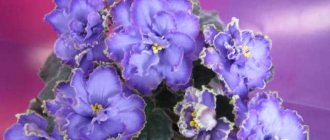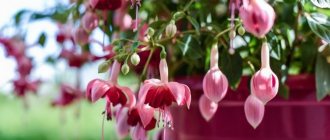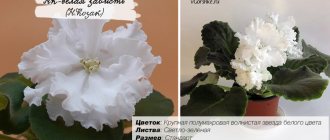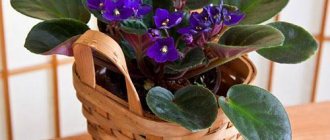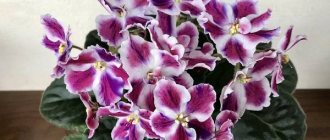In this article you will find the TOP 10 most popular varieties of red violets from breeders E. Lebetskaya, E. Korshunova, K. Morev and other famous breeders.
Violets naturally have blue or purple flowers. Over the years, breeders have worked to improve the varietal qualities of Uzambar violets, and the result of their work has been several thousand varieties of violets.
Today we have varieties with blue, white, pink, purple and even yellow flowers. The red varieties of Saintpaulia deserve special attention.
Red violets create a cozy atmosphere in the house; they go well with interiors decorated in white, cream, blue, yellow or brown tones.
This is a rather unusual color for the Uzambara violet, and every gardener has at least one of these varieties in his collection.
Breeders have not developed many pure red varieties; for this reason, coral and burgundy shades are indicated. Below you will see photos and names of red violets with their brief description.
The history of the flower
It’s quite difficult to even name the homeland of violets.
It grows in Japan, North America, Australia and New Zealand. But it came to Europe from the shores of East Africa.
According to one of the stories about violets, the commandant of German East Africa, Adalbert von Saint-Paul, was walking in the Usambara Mountains with his bride.
She noticed an inconspicuous purple flower between the stones, which had an unsurpassed aroma.
By a lucky coincidence, the commandant’s father was the president of the German Dendrological Society, Ulrich Saint-Paul, to whom the seeds of a flower were sent, “which glows with pale blue fire,” as Adalbert wrote about him in his diaries.
The discoverer's father gave them to the botanist Hermann Wenland, who confirmed that it was a new flower and named it "Saintpaulia" in honor of Adalbert von Saint-Paul.
Violet conquered Europe already at the first exhibition, which was held in Belgium, and at the beginning of the twentieth century, the conquest of the United States began, where a specialized society was opened that was engaged in breeding new varieties of the flower.
Note ! Violet growing wild was familiar back in ancient Greece, where myths and legends were composed about it. But it gained real popularity only in the 19th century.
To date, botanists have managed to develop several thousand varieties of color, despite the fact that initially about 20 species were known.
How to propagate at home
Violets are propagated at home in two ways: by cuttings and dividing the bush.
To take cuttings, follow these steps:
- Cut a leaf from the second row of the peduncle at an angle of 45°.
- Dry the cut.
- Place the cutting in a container of water.
- After some time, the leaf will take root - now it can be planted in the soil.
Dividing the bush is suitable for an adult plant, on which children appear in the process of development.
To transplant children, you must follow the instructions below:
- Separate the children from the outlet using tweezers or toothpicks.
- Plant them in a suitable substrate.
- Cover the container with the babies with a glass cap.
- Remove the cap when the new bush begins to grow.
Types of wild violets
Wild violet is distributed on almost all continents.
Flowers differ according to species and grow in different climatic conditions. Wild plants are different from the violet that has become a houseplant . For wild species of Saintpaulia you need to go to Africa.
About 20 species of wild violets grow on the mountain slopes and waterfalls of Tanzania and Kenya. The flower does not tolerate bright sunlight, so it prefers shaded, damp areas.
The most common and beautiful are the following 3 types:
- “Velvet” Saintpaulia . It is characterized by dark green leaves measuring no more than 5 centimeters. A red tint can be seen on the back of the leaf. The inflorescences are lush, and the flowers are blue-violet, the core is dark.
- “Grote” is a hanging plant. The leaf comes in a purple hue or bright green. Its length reaches 6 cm, and the maximum width is 5 cm. The flowers have a blue-purple hue, with an almost black eye and border.
- “Violet flower” is distinguished by a large rosette, reaching a diameter of more than 50 centimeters. The stems are shortened, the dark green leaves are heart-shaped, the length of which can reach 8 centimeters. The flowers are blue-violet in color.
Note ! Today, many species of wild violets are listed in the Red Book. For example, purple violet is found only in the Caucasus mountains.
In Europe you can see “Forest”, “Amazing” and “Frost-resistant” violets. But they are cultivated quite rarely, being more used as a landscape element. In total, there are more than 25 species of this plant in Eurasia.
Note! On our website there is a series of materials devoted to caring for Saintpaulias: how to grow a plant from a leaf, how to water it correctly, choose a pot and replant. And also how to propagate this plant.
Soil selection
To feed, Saintpaulias need loose and nutrient-rich soil . It is bought in specialized stores. In addition, you can prepare the soil at home yourself.
To do this, mix:
- peat (3 parts) (recommended to be diluted with vermiculite or perlite to retain moisture);
- leaf soil (5 parts);
- perlite (1 part);
- charcoal and vermiculite (no more than 10% of the total mass of the mixture).
For the health of the root system, the composition must allow air and moisture to pass through well.
We recommend watching a video about preparing the correct substrate for violets:
Varieties of indoor violets
Today you can see many cultivated violets, differing in size, shape and shades of leaves, number and shade of petals.
Often one variety has several groups that are slightly different from each other. So, the classification of violets occurs according to the following criteria.
According to socket size
Mini and semi-mini violets are becoming increasingly popular
Plants with a rosette with a diameter of 20-40 centimeters are standard.
If the diameter does not exceed 20 centimeters, it is a semi-mini variety.
Note ! Semi-mini violets do not tolerate excess sunlight.
Plants planted in unshaded areas become sick, the rosette becomes flat, and the foliage turns yellow.
Expert opinion
Nesterenko Ilona Mikhailovna
Florist, specialist in indoor plants. The owner of a country house with a garden and vegetable garden
Mini varieties have a rosette diameter of 12 to 15 centimeters, they are not picky, reproduce well and take root, which makes the plant ideal for growing in the garden.
Tiny compared to standard micromini varieties, they are distinguished by a rosette with a diameter of no more than 8 centimeters. They are grown exclusively indoors and die quickly without water.
Varieties with a compact rosette include, for example, the “Raisin” violet.
Violet “Raisin”
By flower size
Depending on the size of the flower, violets are divided into small-flowered (less than 2 cm), medium-flowered (up to 4 cm), large-flowered (up to 6 cm) and especially large-flowered (more than 6 cm).
According to the shape of the flower
Today, violets are divided into 5 main types. A distinctive feature is the size and arrangement of flowers. You can read more about them below.
Pansies
This type of flower has 5 petals arranged in 2 rows.
The top 2 leaves are smaller than the bottom 3.
The most popular varieties related to Pansies are the following:
- “Lians Pirates Treasure” is a pink flower with a wide crimson border at the edges of the petals. You can see raspberry patches on the border. The leaves have a bubbly structure.
Violet Lines Pirates Treasure - Violets “Cinderella’s Dream” are distinguished by large lace flowers of a light lilac color with a crimson tint. The upper petals are darker than the lower ones. The rosette is made up of green wavy leaves of a dark shade.
- The rosette of “Kimi Melody” is made up of leaf plates. The lower petals of the flower are white with a blue border. The top ones are also blue.
Violet Cinderella's dream
Violet Melodies Kimi
These are not all varieties, since Pansy is one of the most common varieties in the world. But it is simply impossible to mention everything, because you will have to write a multi-volume edition.
Star
A star can be distinguished from others by the same size and symmetry of the flower petals. Among the many varieties, the following stand out:
- “Kev's Heavenly Star” is a rather simple pink flower that resembles a double star. All petals have a dark border.
- The petals of the “Magic of Love” flower resemble ceremonial pompoms in a solid burgundy color. The beet tint and the border of snow-white petals add special chic.
- Double red flowers are characteristic of “Black Prince”. Its rosette is standard, but the sheet on the reverse side has a red tint.
Violet Magic of love
Violet Black Prince
Other popular varieties of Saintpaulia include Rosemary, Zephyr and Austin Smiles. These and many other varieties have won great love among gardeners, but require a lot of attention to care.
Violet “Rosemary”
Violet “Zephyr”
Violet “Austin Smiles”
Note ! Creamy white petals with coral specks turn white when exposed to high temperatures. The plant should be planted in shaded areas.
Bell
Violets belonging to the Bluebells do not open completely, merging at the beginning of the petal. The most common varieties are the following:
- “Admiral” of blue-cornflower blue color is distinguished by semi-double wavy flower petals. The dark green leaves are pointed and decorated with purple edging.
- The blue flowers of “Shining Bell” have wavy edges and a fancy pattern. You can see a yellow peephole inside.
- The “Chanson” variety blooms brightly and for a long time. Flowers are unpretentious. The rosette contains a large number of dark blue, violet and purple flowers.
Among others, one should especially highlight “Robs Dandy Lion”, which in shape and color is quite easily confused with a snowdrop.
The varieties “Royal Lace” and “Wedding Bouquet” boast beautiful white flowers and abundant flowering.
Bowl
This type of color is in many ways similar in features to the “Bell”, but the petals do not grow together at the base and do not open fully. The result is a cup-shaped shape.
The most popular are the soft blue “Boo Man” and the white and pink flowers of the “Ming Dynasty” variety.
Wasp
The petals of this type of violet are separated from each other. Two of them curl into a tube, and three are slightly longer and hang down. From a large group, the following stand out:
- “Lunar Lily White” is a variety that has about 6 double white flowers in an inflorescence with a diameter of up to 4 centimeters.
- The lilac petals of “Zemfira” flowers have both double and simple structure. The rosette is ordinary, but has variegated leaves in the center.
- The rosette of “Sputnik” is quite small (no more than 15 cm), the flowers are colored red-violet.
Violet “Lunar Lily White”
Violet “Zemfira”
In addition to the above types, violets are divided according to a number of other criteria, which will be discussed below.
By degree of terry
Violets are divided into simple, scalloped, semi-double, double and “carnation”.
The first are flowers with 5 petals.
Comb violets are those that have five developed petals and several underdeveloped ones . Saintpaulias with 8 petals, in which the stamens are visible, are semi-double, and flowers with 10 or more petals are double.
Carnations can be confused with double carnations, but they have more petals and are different in size.
Along the edge of the petal
Depending on the edge of the petal, the flowers are divided into fringed, wavy and notched.
By color
Houseplants are also divided according to flower color; detailed information is provided below.
Plain
This type of violet has one tone of petal color, but there are a huge number of color varieties.
You can even find green violets.
The most interesting representatives of this type are “Blue Teal Fly”, which belongs to the “wasps”, and “Gillian” - a representative of the “carnations”.
Violet “Blue Teal Fly”
Violet “Gillian”
Two-tone
Here, too, everything is quite simple - the flower petals are painted in 2 shades of one of the many colors. The color form varies.
Most often, shadows or thickening of color from the central part to the edges are observed.
Interesting representatives are “Ice Rose”, “Amadeus”, “Marie-Sylvia”, “Rum Punch”, “Frosty Cherry”.
Violet “Amadeus”
Violet “Ice Rose”
Violet “Rum Punch”
Violet “Frosty Cherry”
Two-color or multi-color
In this case, most often you can see petals of the same color with a border painted in a shade of contrasting color. Most often, gardeners can find violets of the “Iceberg” and “Through the Looking Glass” varieties.
Violet “Iceberg”
Note ! A number of varieties have not one, but two borders. A striking example of this is the “Looking Glass” violets.
Violet “Looking Glass”
Limbed
These varieties of violets that have one or more edgings include the varieties Windrose, Natalis, Estravagante, Macho, Modern Talking and others.
Violet “Modern Talking”
Violet “Macho”
Finger color
Looking at a violet of this variety, you might think that it was doused with paint and then smeared with your finger. The strokes are most often found in the middle of the petal, but not always. Prominent representatives are “Crimson Ice” and “Southern Spring”.
Finger-colored violet
Peephole
In Eyes, the flower petals are painted in one color, but in the middle there is a speck with a color that matches the main color or, conversely, a contrasting shade. The most famous variety is “EK-8 March”.
Violet “EK-8 March”
Mesh
This color is formed due to the contrasting veins on the petals. It can boast of rare varieties, including “Granger”, “Carnival” and “Feather”.
Violet “Carnival”
Chimera violets
The color of the chimera is similar to a mesh, but the stripes go from the middle, and they are of different colors. The most striking representatives are the varieties “Chain Reaction” and “Queen Sabrina”.
Violet “Queen Sabrina”
Violet “Chain Reaction”
Fantasy
The name of this type of color speaks for itself. These are flowers of different colors with bizarre shapes and patterns. Some of the most beautiful are “Chimpansy” and “Live wire”.
Violet “Live wire”
Violet “Chimpansi”
A striking example is the Dance of Galaxies.
Violet “Dance of the Galaxy”
Peculiarities
Tremendous selection work was done in relation to these violets. The following distinctive features of Saintpaulia bred by the breeder can be distinguished:
- Large and very large flowers on the scale of violets.
- Unusual color (green petals, three colors at once, fancy specks, bright edging and others).
- Flowers of complex shape (double, multi-layered, corrugated).
- Flowering is long and abundant (a month or more with short periods of calm).
- In her own words, the breeder strives for the plant’s resistance to burning.
Natalya Skornyakova also collects her collection according to the following principles:
- Compact rosette (compact standard rosette at the first flowering with a diameter of 15 -20 cm, large standard more than 25 cm).
- The beginning of flowering from the moment the leaf is planted is one year, plus or minus one or two months.
- Good immunity.
- Certain soil.
Ampelous
Ampelous varieties are a fairly young type of violet with a long stem and a variegated color of different colors. Some of the most beautiful are “Ramblin Dots” and “Fallin Snow”.
Violet “Ramblin Dots”
Violet “Foline Snow”
What should the capacity be?
You need to decide on the choice of container for the flower, its size and material. Suitable containers made of plastic and ceramics. A plastic pot is lightweight and durable, but it is not breathable .
Important : In a large container, the plant develops a root system without tending to flowering. For the abundant appearance of flower stalks, a small pot is required. There should be holes at the bottom of the pot to drain excess water.
We recommend watching a video about choosing the right pot for violets:
The most popular varieties
Among the most common varieties are the following:
- “Isadora” is a flower somewhat reminiscent of peonies.
- “Lituanica” - looks like a mixture of tea rose, dahlia and rosehip.
- “Rosemary” is one of the most delicate representatives of violets with a beautiful purple pattern on a pink background.
Violet “Isadora”
Violet “Lituanica”
Violet “Rosemary”
Of course, these are not all varieties loved by many. You can also note “Darling”, “Paul Bunyan”, “Duchess” and others.
Violet “Paul Bunyan”
Reviews
Larisa Sergeevna. “ Violet “RM-Magic Tulip” requires close attention when forming an adult bush - otherwise it can form a shaggy rosette. But then she pleases with lush blooms with marvelous flowers of extraordinary texture, like small tulips. I recommend this magical variety to everyone!”
Saintpaulia attracts the attention of many gardeners.
The most unusual violets
It should be noted that this flower can be quite unusual, for which it is highly valued by flower growers, because you never know what the outcome will be. The most interesting varieties are the following:
- “Chimera” is a variety resulting from the mutation of two plant species. The color of the petals varies from blue to crimson, but there is always a light dividing line in the middle.
- An exotic variety called “Crimson Cloud Country” has a dark crimson color with an intricate pattern.
- “Gray Ocean” is a flower that has the ability to change color to suit the mood, turning from white to lilac. With each flowering it becomes darker, and the Gray Ocean variety turns into the Black Pearl.
Violet “Chimera”
Violet “Land of Crimson Clouds”
Violet “Grey Ocean”
There are a lot of varieties of violets; every year breeders try to present something new and unique at exhibitions, so it is not possible to mention them all. But each of the varieties is unique and beautiful in its own way.
The article examined the main varieties of indoor violets. This is a beautiful flower that can decorate any space.
For those who are interested in this plant, but have no experience in growing it, we recommend starting with mini violets. Exhibition varieties are more beautiful, but have a lot of nuances in breeding, which will turn a hobby into exhausting work.
However, regardless of the choice, the interior of the room, decorated with live violets, will be transformed beyond recognition.
We recently learned that there are quite a lot of signs and superstitions associated with this plant. Read about them in the material at the link.
Briefly about the breeder N. Skornyakova
Information : Breeder Natalya Skornyakova lives in the city of Kursk. There, together with another breeder Tatyana Pugacheva, she is breeding new varieties of violets.
You can read about violets bred by Tatyana Pugacheva in this article.
Each of them represents its own varieties. The names of the varieties of violets created by Natalya contain the prefix RM (these are the initials of the breeder’s mother; she dedicates the fruits of her work to her). She began the selection and distribution of varieties in 2012.
Diseases
The development of these plants is often hampered by diseases and parasites. Common diseases include late blight, gray and brown rot, root rot, and powdery mildew.
- Late blight is characterized by brown spots on the leaves and rotting roots. The plant affected by it is completely eliminated, and the container is disinfected. Superphosphate is added for protection.
- For gray rot (gray spots on any part of the plant), the damaged parts are removed, and the plant is replanted and treated with a fungicide.
- Powdery mildew is identified by whitish marks on the leaves. To combat it, the drug Fundazol is used.
Pests
The flower can be attacked by pests - mites, aphids, thrips, scale insects, whiteflies, nematodes, false scale insects and other insects. Acaricides help against ticks, the drug Agravertin helps against scale insects, and thrips cannot tolerate the insecticide Aktara.
These violets get sick due to improper growth conditions . Diseases are easier to prevent than to treat.
For those who decide to grow this miracle called violet, we suggest familiarizing yourself with the most interesting options bred by such famous breeders as E. Korshunova (Shanghai rose, Charmel), E. Arkhipov (Egorka well done, Aquarius), N. Puminova ( Fun, Madame), A. Tarasov (Bomb, Tango), K. Morev (Burnt Sun, Olesya), S. Repkina (Georgette, Green Lagoon), E. Lebetskaya (Giselle, Carousel), T. Dadoyan (Fairy), as well as Boris and Tatyana Makuni (Coquette, Jupiter).

